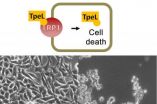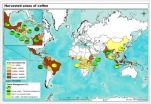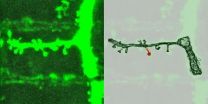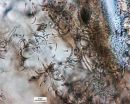(Press-News.org) Everything we do — all of our movements, thoughts and feelings – are the result of neurons talking with one another, and recent studies have suggested that some of the conversations might not be all that private. Brain cells known as astrocytes may be listening in on, or even participating in, some of those discussions. But a new mouse study suggests that astrocytes might only be tuning in part of the time — specifically, when the neurons get really excited about something. This research, published in Neuron, was supported by the National Institute of Neurological Disorders and Stroke (NINDS), part of the National Institutes of Health.
For a long time, researchers thought that the star-shaped astrocytes (the name comes from the Greek word for star) were simply support cells for the neurons.
It turns out that these cells have a number of important jobs, including providing nutrients and signaling molecules to neurons, regulating blood flow, and removing brain chemicals called neurotransmitters from the synapse. The synapse is the point of information transfer between two neurons. At this connection point, neurotransmitters are released from one neuron to affect the electrical properties of the other. Long arms of astrocytes are located next to synapses, where they can keep tabs on the conversations going on between neurons.
In recent years, it has been shown that astrocytes may also play a role in neuronal communication. When neurons release neurotransmitters, levels of calcium change within astrocytes. Calcium is critical for many processes, including release of molecules from the cell, and activation of a host of proteins within the cell. The role of this astrocytic calcium signaling for brain function remains a mystery.
In this study, Baljit S. Khakh, Ph.D., of the University of California, Los Angeles and his colleagues wanted to know when astrocytes responded to neuron activity with changes in their internal calcium levels. Using calcium indicator dyes, the researchers were able to image, for the first time, changes in calcium levels in the entire astrocyte. Previously, it was only possible to look at certain areas of the cell at one time, which provided an incomplete picture of what was happening.
Dr. Khakh said one of the most important outcomes of this work was in the methods that were used. "What our use of these calcium indicators shows is that we can image calcium throughout the entire astrocyte. This provides a new set of tools for the research community to use and to extend these findings," he said.
"There has been intense interest in understanding how astrocytes facilitate communication between neurons, but it is only recently that studies with this level of precision have been possible," said Edmund Talley, Ph.D., program director at NINDS. "Dr. Khakh's study is an example of an exciting basic, or fundamental, research project that could have an important contribution to the shifting field of astrocyte biology," he added.
For these experiments, researchers focused on the mossy fiber pathway, which connects two areas of the hippocampus, the structure involved in learning and memory. "This pathway has a unique architecture and although it has been very well studied, the role of astrocytes in this circuit has not been previously explored. This study provides one of the first really detailed understandings of astrocytes within this particular circuit," said Dr. Khakh.
Dr. Khakh's team activated neurons (getting them to release neurotransmitter by a variety of techniques) and then looked for a response in the neighboring astrocyte. As calcium levels rose, the astrocyte would light up quickly. They discovered that two neurotransmitters, glutamate and GABA, triggered the astrocytes to release calcium from their internal stores. Importantly, the researchers discovered that calcium levels increased through the entire astrocyte only if there was a large burst of neurotransmitter being released.
"We found that astrocytes in the mossy fiber pathway do not listen to the constant, millisecond by millisecond synaptic chatter that neurons engage in. Instead, they listen when neurons get excessively excited during bursts of activation," said Dr. Khakh.
These findings suggest that astrocytes in the mossy fiber system may act as a switch that reacts to large amounts of neuronal activity by raising their levels of calcium. These calcium increases occur over multiple seconds, a relatively long time period compared to that seen in neurons. The spatial extent of the astrocyte calcium increases was also relatively large in comparison to the size of the synapse.
"Astrocytes may be sitting there quietly and when there is excessive activation in the neuronal circuit, they immediately respond with an increase in calcium which we could detect. And the next big question becomes, what they do with that calcium?" said Dr. Khakh.
Dr. Khakh's results in the mossy fiber system differ from those others have described in other brain regions. This raises the intriguing possibility that astrocytes are not all the same and may serve various roles throughout the brain.
"It would be really interesting and important to find that astrocytes function differently in different areas of the brain, in a circuit-specific manner. This study gives a hint that this might be true," said Dr. Talley.
INFORMATION:
This work was supported by grants from the NINDS (NS060677, NS007101, NS049501, NS074312).
References:
MD Haustein et al. "Conditions and constraints for astrocyte calcium signaling in the hippocampal mossy fiber pathway," Neuron, April 16, 2014.
NINDS is the nation's leading funder of research on the brain and nervous system. The mission of NINDS is to seek fundamental knowledge about the brain and nervous system and to use that knowledge to reduce the burden of neurological disease.
About the National Institutes of Health (NIH): NIH, the nation's medical research agency, includes 27 Institutes and Centers and is a component of the U.S. Department of Health and Human Services. NIH is the primary federal agency conducting and supporting basic, clinical, and translational medical research, and is investigating the causes, treatments, and cures for both common and rare diseases. For more information about NIH and its programs, visit http://www.nih.gov.
Eavesdropping on brain cell chatter
NIH-funded researchers develop novel tools to learn how astrocytes listen in on neurons
2014-04-16
ELSE PRESS RELEASES FROM THIS DATE:
How kids' brain structures grow as memory develops
2014-04-16
Our ability to store memories improves during childhood, associated with structural changes in the hippocampus and its connections with prefrontal and parietal cortices. New research from UC Davis is exploring how these brain regions develop at this crucial time. Eventually, that could give insights into disorders that typically emerge in the transition into and during adolescence and affect memory, such as schizophrenia and depression.
Located deep in the middle of the brain, the hippocampus plays a key role in forming memories. It looks something like two curving fingers ...
Theoretical biophysics: Adventurous bacteria
2014-04-16
To reproduce or to conquer the world? Surprisingly, bacteria also face this problem. Theoretical biophysicists at Ludwig-Maximilians-Universitaet (LMU) in Munich have now shown how these organisms should decide how best to preserve their species.
The bacterium Bacillus subtilis is quite adaptable. It moves about in liquids and on agar surfaces by means of flagella. Alternatively, it can stick to an underlying substrate. Actually, the bacteria proliferate most effectively in this stationary state, while motile bacteria reproduce at a notably lower rate.
In order to sustain ...
Significant baseline levels of arsenic found in Ohio soils are due to natural processes
2014-04-16
RICHLAND, Wash. – Geologic and soil processes are to blame for significant baseline levels of arsenic in soil throughout Ohio, according to a study published recently in the Journal of Environmental Quality.
The analysis of 842 soil samples from all corners of Ohio showed that every single sample had concentrations higher than the screening level of concern recommended by the U.S. Environmental Protection Agency. The findings should not alarm the public, say the authors, who note that regulatory levels typically are set far below those thought to be harmful. Rather, the ...
Preterm births, multiples, and fertility treatment
2014-04-16
While it is well known that fertility treatments are the leading cause of increases in multiple gestations and that multiples are at elevated risk of premature birth, these results are not inevitable, concludes an article in Fertility and Sterility. The article identifies six changes in policy and practice that can reduce the odds of multiple births and prematurity, including expanding insurance coverage for in vitro fertilization (IVF) and improving doctor-patient communications about the risks associated with twins.
Financial pressures provide a powerful incentive for ...
Gate for bacterial toxins found
2014-04-16
Prof. Dr. Dr. Klaus Aktories and Dr. Panagiotis Papatheodorou from the Institute of Experimental and Clinical Pharmacology and Toxicology of the University of Freiburg have discovered the receptor responsible for smuggling the toxin of the bacterium Clostridium perfringens into the cell. The TpeL toxin, which is formed by C. perfringens, a pathogen that causes gas gangrene and food poisoning. It is very similar to the toxins of many other hospital germs of the genus Clostridium. The toxins bind to surface molecules and creep into the body cell, where they lead to cell death. ...
Scientists explain how memories stick together
2014-04-16
LA JOLLA—Scientists at the Salk Institute have created a new model of memory that explains how neurons retain select memories a few hours after an event.
This new framework provides a more complete picture of how memory works, which can inform research into disorders liked Parkinson's, Alzheimer's, post-traumatic stress and learning disabilities.
"Previous models of memory were based on fast activity patterns," says Terry Sejnowski, holder of Salk's Francis Crick Chair and a Howard Hughes Medical Institute Investigator. "Our new model of memory makes it possible to ...
Shade grown coffee shrinking as a proportion of global coffee production
2014-04-16
The proportion of land used to cultivate shade grown coffee, relative to the total land area of coffee cultivation, has fallen by nearly 20 percent globally since 1996, according to a new study by scientists from The University of Texas at Austin and five other institutions.
The study's authors say the global shift toward a more intensive style of coffee farming is probably having a negative effect on the environment, communities and individual farmers.
"The paradox is that there is greater public interest than ever in environmentally friendly coffee, but where coffee ...
Synapses -- stability in transformation
2014-04-16
This news release is available in German. Synapses are the points of contact at which information is transmitted between neurons. Without them, we would not be able to form thoughts or remember things. For memories to endure, synapses sometimes have to remain stable for very long periods. But how can a synapse last if its components have to be replaced regularly? Scientists from the Max Planck Institute of Neurobiology in Martinsried near Munich have taken a decisive step towards answering this question. They have succeeded in demonstrating that when a synapse is formed, ...
Scratching the surface: Microbial etchings in impact glass and the search for life on Mars
2014-04-16
Boulder, Colo., USA – Haley M. Sapers and colleagues provide what may be the first report of biological activity preserved in impact glass. Recent research has suggested that impact events create novel within-rock microbial habitats. In their paper, "Enigmatic tubular features in impact glass," Sapers and colleagues analyze tubular features in hydrothermally altered impact glass from the Ries Impact Structure, Germany, that are remarkably similar to the bioalteration textures observed in volcanic glasses.
The authors note that mineral-forming processes cannot easily ...
Cancer drugs block dementia-linked brain inflammation, UCI study finds
2014-04-16
Irvine, Calif., April 16, 2014 — A class of drugs developed to treat immune-related conditions and cancer – including one currently in clinical trials for glioblastoma and other tumors – eliminates neural inflammation associated with dementia-linked diseases and brain injuries, according to UC Irvine researchers.
In their study, assistant professor of neurobiology & behavior Kim Green and colleagues discovered that the drugs, which can be delivered orally, eradicated microglia, the primary immune cells of the brain. These cells exacerbate many neural diseases, including ...
LAST 30 PRESS RELEASES:
Ships trigger high and unexpected emissions of the greenhouse gas methane
Optimizing laser irradiation: An in-silico meta-analysis of skin discoloration treatment
Climate crisis could force wild vanilla plants and pollinating insects apart, threatening global supply
Teens report spending 21% of each driving trip looking at their phone
Study explores the ‘social norms’ of distracted driving among teens
Diver-operated microscope brings hidden coral biology into focus
Enhancing the “feel-good” factor of urban vegetation using AI and street view images
A single genetic mutation may have made humans more vulnerable to cancer than chimpanzees
Innovative nanocomposite hydrogel shows promise for cartilage regeneration in osteoarthritis treatment
2025 Guangci Laboratory Medicine Innovation and Development Conference
LabMed Discovery is included in the ICI World Journals database
LabMed Discovery is included in the China Open Access Journal (COAJ) database
Vaccination support program reduces pneumonia-related mortality by 25 percent among the elderly
Over decades, a healthy lifestyle outperforms metformin in preventing onset of Type 2 diabetes
Mental health disorders, malaria, and heart disease most affected by covid pandemic
Green transition will boost UK productivity
Billions voted in 2024, but major new report exposes cracks in global democracy
Researchers find “forever chemicals” impact the developing male brain
Quantum leap in precision sensing across technologies
Upgrading biocrude oil into sustainable aviation fuel using zeolite-supported iron-molybdenum carbide nanocatalysts
For effective science communication, ‘just the facts’ isn’t good enough
RT-EZ: A golden gate assembly toolkit for streamlined genetic engineering of rhodotorula toruloides
Stem Cell Reports announces five new early career editors
Support networks may be the missing link for college students who seek help for excessive drinking
The New England Journal of Medicine shines spotlight on forensic pathology
Scientists discover protein that helps lung cancer spread to the brain
Perceived social status tied to cardiovascular risks in women but not in men
Brain tumor growth patterns may help inform patient care management
This might be America's first campus tree inventory
Emoji use may impact relationship outcomes
[Press-News.org] Eavesdropping on brain cell chatterNIH-funded researchers develop novel tools to learn how astrocytes listen in on neurons







